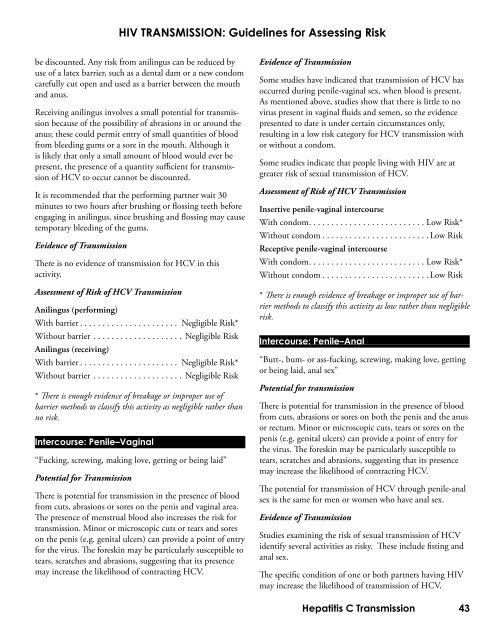HIV transmission: guidelines for assessing risk - Canadian AIDS ...
HIV transmission: guidelines for assessing risk - Canadian AIDS ...
HIV transmission: guidelines for assessing risk - Canadian AIDS ...
- No tags were found...
You also want an ePaper? Increase the reach of your titles
YUMPU automatically turns print PDFs into web optimized ePapers that Google loves.
<strong>HIV</strong> TRANSMISSION: Guidelines <strong>for</strong> Assessing Riskbe discounted. Any <strong>risk</strong> from anilingus can be reduced byuse of a latex barrier, such as a dental dam or a new condomcarefully cut open and used as a barrier between the mouthand anus.Receiving anilingus involves a small potential <strong>for</strong> <strong>transmission</strong>because of the possibility of abrasions in or around theanus; these could permit entry of small quantities of bloodfrom bleeding gums or a sore in the mouth. Although itis likely that only a small amount of blood would ever bepresent, the presence of a quantity sufficient <strong>for</strong> <strong>transmission</strong>of HCV to occur cannot be discounted.It is recommended that the per<strong>for</strong>ming partner wait 30minutes to two hours after brushing or flossing teeth be<strong>for</strong>eengaging in anilingus, since brushing and flossing may causetemporary bleeding of the gums.Evidence of TransmissionThere is no evidence of <strong>transmission</strong> <strong>for</strong> HCV in thisactivity.Assessment of Risk of HCV TransmissionAnilingus (per<strong>for</strong>ming)With barrier . . . . . . . . . . . . . . . . . . . . . . Negligible Risk*Without barrier . . . . . . . . . . . . . . . . . . . . Negligible RiskAnilingus (receiving)With barrier . . . . . . . . . . . . . . . . . . . . . . Negligible Risk*Without barrier . . . . . . . . . . . . . . . . . . . . Negligible Risk* There is enough evidence of breakage or improper use ofbarrier methods to classify this activity as negligible rather thanno <strong>risk</strong>.Intercourse: Penile–Vaginal“Fucking, screwing, making love, getting or being laid”Potential <strong>for</strong> TransmissionThere is potential <strong>for</strong> <strong>transmission</strong> in the presence of bloodfrom cuts, abrasions or sores on the penis and vaginal area.The presence of menstrual blood also increases the <strong>risk</strong> <strong>for</strong><strong>transmission</strong>. Minor or microscopic cuts or tears and soreson the penis (e.g. genital ulcers) can provide a point of entry<strong>for</strong> the virus. The <strong>for</strong>eskin may be particularly susceptible totears, scratches and abrasions, suggesting that its presencemay increase the likelihood of contracting HCV.Evidence of TransmissionSome studies have indicated that <strong>transmission</strong> of HCV hasoccurred during penile-vaginal sex, when blood is present.As mentioned above, studies show that there is little to novirus present in vaginal fluids and semen, so the evidencepresented to date is under certain circumstances only,resulting in a low <strong>risk</strong> category <strong>for</strong> HCV <strong>transmission</strong> withor without a condom.Some studies indicate that people living with <strong>HIV</strong> are atgreater <strong>risk</strong> of sexual <strong>transmission</strong> of HCV.Assessment of Risk of HCV TransmissionInsertive penile-vaginal intercourseWith condom . . . . . . . . . . . . . . . . . . . . . . . . . . Low Risk*Without condom . . . . . . . . . . . . . . . . . . . . . . . . Low RiskReceptive penile-vaginal intercourseWith condom . . . . . . . . . . . . . . . . . . . . . . . . . . Low Risk*Without condom . . . . . . . . . . . . . . . . . . . . . . . . Low Risk* There is enough evidence of breakage or improper use of barriermethods to classify this activity as low rather than negligible<strong>risk</strong>.Intercourse: Penile–Anal“Butt-, bum- or ass-fucking, screwing, making love, gettingor being laid, anal sex”Potential <strong>for</strong> <strong>transmission</strong>There is potential <strong>for</strong> <strong>transmission</strong> in the presence of bloodfrom cuts, abrasions or sores on both the penis and the anusor rectum. Minor or microscopic cuts, tears or sores on thepenis (e.g. genital ulcers) can provide a point of entry <strong>for</strong>the virus. The <strong>for</strong>eskin may be particularly susceptible totears, scratches and abrasions, suggesting that its presencemay increase the likelihood of contracting HCV.The potential <strong>for</strong> <strong>transmission</strong> of HCV through penile-analsex is the same <strong>for</strong> men or women who have anal sex.Evidence of TransmissionStudies examining the <strong>risk</strong> of sexual <strong>transmission</strong> of HCVidentify several activities as <strong>risk</strong>y. These include fisting andanal sex.The specific condition of one or both partners having <strong>HIV</strong>may increase the likelihood of <strong>transmission</strong> of HCV.Hepatitis C Transmission43
















